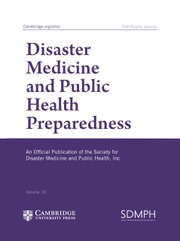No CrossRef data available.
Article contents
How Does Network Media Affect the Efficiency of Emergency Response During Natural Disaster Process?
Published online by Cambridge University Press: 26 November 2024
Abstract
This paper delves into the influence of network media on the efficacy of emergency response during natural disasters. Given the frequent occurrence of disasters that pose significant risks to urban areas, effective emergency response mechanisms are paramount. Leveraging the Data Envelopment Analysis (DEA) model, this study assesses disaster response efficiency by analyzing network information. It explores the distinct characteristics of disaster response across different types of natural disasters and their various occurrence stages. To this end, three emblematic disasters are chosen for empirical analysis: the 2021 Zhengzhou heavy rainstorm, the 2022 Super Typhoon Chaba, and the 2022 Luding earthquake. Our findings reveal disparities in response efficiency among these disaster types, with Zhengzhou’s rainstorm response demonstrating the highest efficiency, followed by the Super Typhoon Chaba, and the Luding earthquake yielding the lowest efficiency. Furthermore, this study meticulously discusses the pivotal factors that shape response efficiency, encompassing government decision-making, emergency rescue operations, and social assistance. By pinpointing optimal response strategies tailored to distinct disaster stages, this paper underscores its contribution toward augmenting disaster response efficiency and fostering urban safety and disaster preparedness.
- Type
- Review Article
- Information
- Copyright
- © The Author(s), 2024. Published by Cambridge University Press on behalf of Society for Disaster Medicine and Public Health, Inc.


